
GLENN LONEY'S SHOW NOTES
By Glenn Loney, December 1, 2000

| |
|
Caricature of Glenn Loney by Sam Norkin. |
|
[02] Banking on Bankhead
[03] Solo Shows
[04] Modern Classics Disinterred
[05] New Dramas
[06] Other Theatre Manifestations
[07] "Guys & Dolls" at Museum of City of New York
[08] Joanna Rotté's "Acting with Adler"
You can use your browser's "find" function to skip to articles on any of these topics instead of scrolling down. Click the "FIND" button or drop down the "EDIT" menu and choose "FIND."
How to contact Glenn Loney: Please email invitations and personal correspondences to Mr. Loney via Editor, New York Theatre Wire. Do not send faxes regarding such matters to The Everett Collection, which is only responsible for making Loney's INFOTOGRAPHY photo-images available for commercial and editorial uses.
How to purchase rights to photos by Glenn Loney: For editorial and commercial uses of the Glenn Loney INFOTOGRAPHY/ArtsArchive of international photo-images, contact THE EVERETT COLLECTION, 104 West 27th Street, NYC 10010. Phone: 212-255-8610/FAX: 212-255-8612.
For a selection of Glenn Loney's previous columns, click here.
New York Fall Season Survey:
CAVEAT: In the spirit of the "compassionate downsizing" which will distinguish our new Administration, this edition of Show Notes will simply survey the productions which have been seen this fall, between photo-safaris to China, Tibet, and Ireland. Each will be given a rating [*****] and a brief comment. Those which have already closed are included because either the work itself or the production—or both—deserve attention—and a longer life.MUSICALS & REVUES—
"The Full Monty" [****]
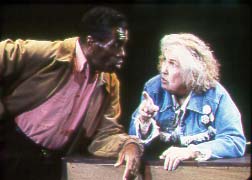
| |
| Andre De Shields gets advice from old trouper Kathleen Freeman in "The Full Monty." | |
"The Rocky Horror Show" [***]
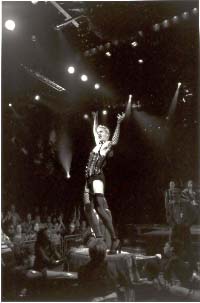
|
| Tom Hewitt as Dr. Frank 'N' Furter in "The Rocky Horror Show." Photo: ©Carol Rosegg. |
"A Class Act" [****]
Surprisingly, the songs of the late Ed Kleban—which he vainly tried to place on Broadway—will get there after all. His "Chorus Line" lyrics gave him some small fame, but in his lifetime he never won acclaim as a composer. The attractive little "memorial" show which Linda Kline and Lonny Price have devised from his life and his music now can do this for him. At the Manhattan Theatre Club, as Kleban, Price is as prickly as the man himself: a Woody Allen neurotic with talent.
"The Gorey Details" [***]
Those who are not fans of the ghoulish drawings and mordantly bizarre fables of the late Edward Gorey will avoid this musical, either on stage or on CD. Peter Matz has set Gorey texts to mildly appropriate music. A ghoulishly Gorey cast and props at the Century Theatre bring such tales as "The Weeping Chandelier" to half-life, in a merry mortuary manner.
"4 Guys Named José…and una mujer named María" [**]
If you are starved for Latino renditions of "Perfidia" or "Besame Mucho," this may be just the ticket for you. If the conceit of performing an amateur cabaret in a mid-western Veterans of Foreign Wars Hall tickles your fancy, this is definitely the show for you! But don't expect Julio Iglesias or Tito Puente at the Blue Angel in this one.
Batoto Yetu in "The Mukishi" [***]
Dynamic dancing, drumming, and singing—in often striking costumes—electrified the stage of the New Victory on "New 42." But the young ensemble's engagement was all too brief. The Aussies' Circus Oz is on view all December, but this show could return.
"American Rhapsody" [***]
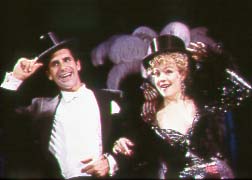
| |
| Mark Nadler & K. T. Sullivan sing Gershwin on West 72nd. Photo: ©Carol Rosegg. | |
Banking on Bankhead—
Two down and one to go! Tallulah Bankhead is waiting in the wings for her one-woman show later in the season. In the meantime, Tovah and Nan Schmid are on stage.
"Tallulah Hallelujah!" [***]
Tovah Feldshuh has style and dynamism all her own. It enables her to will herself into an evocation of Tallu' on one of the worst days of her life. She has just been savaged for playing Blanche Dubois at City Center and now must host the Stage-Door Canteen anniversary alone. Tallulah was never much of a singer: more a song-stylist. This suits Tovah well, but the Bankhead memories might have been more fun recalled on a happier day. She's at the Douglas Fairbanks.
"Dahling: The Life & Times of Tallulah Bankhead" [***]
Not only has Nan Schmid drafted this tab version of Tallulah's life, but she's also chosen to star in it. Oddly enough, her distinctive face would be ideal for an Evening with Fanny Brice. Or even Barbra Streisand—which is almost the same thing. The able cast of eight impersonates a Rogues' Gallery of Performing Arts Celebrities Past at the Grove Street Theatre.SOLO SHOWS—
To be both accurate and Politically Correct, one can no longer use the One-Man-Show category. Often, the best of this inexpensive genre are performed by women. And, considering all the support-troops needed for costume & prop changes—not to mention walk-ons, as employed by Dame Edna last season—the stars are not out there in the evening sky alone.
"LES MIZrahi" [****]
Isaac Mizrahi is your Basic Artistic Jewish Boy from Brooklyn. He may have won fame as a fashion-designer, but, deep down, he just wants to be loved. He comes right out and says so. He is also gay, which he discloses during some interfacing with the audience, noting that he has to conceal that on stage. [Ho-ho!] He whips up a caftan on stage on his old sewing-machine and shares Rice Krispie Treats with the audience. He's charming, disarming, and he sings fairly well. A fun evening at Greenwich House, courtesy of the Drama Department.
"The Search for Signs of Intelligent Life in the Universe" [****]
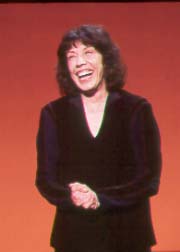
| |
| Lily Tomlin searches for Intelligent Life at the Booth Theatre. Photo: ©Carol Rosegg. | |
"Roamin' Holiday: A View from a Broad" [****]
Artist, satirist, and performance-artist Pat Oleszko may never make it to Broadway and the "tiny Booth Theatre," as a miffed Dame Edna described it. But she has a very big heart, talent, and imagination. Her current show—recently at PS 122—is the distillation of a year's grant-funded research and roaming around Millennial Rome in the Holy Year. Oleszko—who was once a Beauty Queen—is famed on the Fringe for her inflatable structures, props, and people, as well as her bizarre costumes and puppets. Her constructions and art-videos have been shown at the American Craft Museum and on TV. One of her costumes in the current show is a gaggle of Roman nuns, with Oleszko in the center, animating the group. She also appears as a burlesque Pontiff, the Nincompope: Banned at Vatican City. Oleszko takes no prisoners in her social & cultural critiques. Of the Sacred Host, she says: "Jesus on a cracker!"MODERN CLASSICS DISINTERRED—
"Gore Vidal's The Best Man" [****]
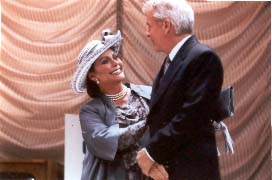
|
| Elizabeth Ashley charms Gore Vidal's "Best Man," Spalding Gray. Photo: ©Peter Cunningham. |
A Roundabout Trio—
"The Man Who Came To Dinner" [****]
This was a handsome inaugural production for the "New 42" American Airlines Theatre. The stage-decor even echoed the colorful restoration of what was once the interior of the Selwyn Theatre—which is actually on 43rd Street. Having seen an interesting, thoughtful revival of the Kaufman & Hart comedy only a few months before—in Ashland, at the Oregon Shakespeare Festival—I was amused to compare the two, in terms of dramatic truth, versus comedic caricature. The Roundabout's Broadway production was certainly slick, and Nathan Lane was ardently acerbic in harpooning his sitting targets. Of course, he was no Monty Wooley, but how many in the audience would remember that distinguished performance?For those Historical Theatre buffs who are outraged at the Selwyn's new name, someone had to help pay the bills. Indeed, in distant Scotland, the major venue for the annual Edinburgh International Film Festival is also called the American Airlines Theatre.
"Juno and the Paycock" [***]
Despite the energy the actors—and the expense the Roundabout Theatre on East 23—expend on revivals of Irish and English modern classics, it is often a relief to see Sean O'Casey and other Irish Masters brought back to life at the Irish Rep. Where they don't have to waste so much of their rehearsal-time and performance-energy on getting their brogues right. Despite the valiant and authentic efforts of Eire's Dearbhla Molloy to bring Juno Boyle to vibrant life on stage, others in the cast were awash in blather. This is a powerful and pathos-packed slice-of-life, but in this production, it just seemed a hard slog from Act II to Act III.
"Betrayal" [***]
Running the story in reverse proved fatal for "Merrily We Roll Along." And it didn't work so well in the original play, for the main characters matured into dreadful people. It was a distinct downer to meet them initially as the monsters they gradually became. Some pundits have suggested Harold Pinter borrowed this device for "Betrayal." Being Pinter, it could as well have spontaneously occurred to him, as it serves him very well. The married couple and the best friend who has liaisons with the wife over a period of years are not monsters. They are intelligent human-beings—perhaps with more IQ than common sense. It is still fascinating to trace the end, growth, and beginning of the affair in this revival at the American Airlines Theatre. Even more so, given the unaffected simplicity and artless charm of Juliette Binoche. As her lover, Liev Schreiber has all the charisma of the Great Stone Face. At least the Roundabout doesn't serve you inflight airline dinners!
Three Forgotten Plays at the Mint—
"Welcome To Our City" [***]
I cherish the Mint Theatre and its director, Jonathan Bank, for their dedication to giving important—or long-forgotten—American and British dramas thoughtful and thoroughly professional revivals in their small 5th-floor theatre on West 43. These productions are mounted on the proverbial shoestring, but, though simple, the sets and costumes are always appropriate and effective, never garish or shabby.That was certainly the case with Thomas Wolfe's "Welcome To Our City," set in 1922, and dealing with a number of "Southern Issues" which reveal this young American novelist as an amazingly enlightened son of the South. The title refers to a southern town, afflicted with the 1920s viruses of Boosterism and Real Estate Development. Beneath the glad-handing surface, however, lurk dark secrets and rampant racism. The drama proved a youthful effort, insecure in its dramaturgy, but a harbinger of the social consciousness Wolfe would bring to such works as "The Web and the Rock," "Of Time and the River," and "You Can't Go Home Again."
My first experience of the Mint's historic revivals was their staging of "Uncle Tom's Cabin." This offended some critics and spectators, who thought Harriet Beecher Stowe's fictional stereotypes should not be revived, even out of historical curiosity. James Earl Jones' dad sat near me, and he seemed to savor this evocation of past prejudice and suffering. for what it was: a cultural artifact of the life and theatre of another time.
Personal Disclosure: Jonathan Bank sought me out for permission to stage my edition of Edith Wharton and Clyde Fitch's dramatization of Mrs. Wharton's brilliant novel, "The House of Mirth" at the Mint. I had discovered the few surviving typescript versions of this Broadway failure fifty years ago, while writing my dissertation at Stanford University. The Mint did Mrs. Wharton and her doomed heroine, Lily Bart, proud!
"The Flattering Word" [**]
This comic trifle would have been a curtain-raiser—or a vaudeville sketch—but it is also a George Kelly pot-boiler, not in the league of "The Show-Off." The plot device is telling sworn enemies of theatre—even a priggish minister—that they are so effective in personality, gesture, and speech that they should have gone on the stage. It works like a charm in this brief comedy. And it is, in fact, the curtain-raiser for a previously unproduced play by Harley Granville Barker.
"Farewell To the Theatre" [****]
Behind the characters so beautifully played by Sally Kemp and George Morfogen is Granville Barker himself, preparing to leave the theatre physically and emotionally as well. This thoughtful drama is his valedictory. Kemp's Dorothy is a famed actress-manager, much like Mrs. Patrick Campbell. Morfogen's Edward is a lawyer—who has always loved and admired her—who must make her realize that her day as a star and her kind of play have passed from the scene. The drama is both tender and touching.Mrs. Pat, in fact, was so impoverished toward the end that she had to sell her costumes, her prompt-books—including one for a play Edith Wharton had adapted for her, and her Bernard Shaw letters. [Personal Disclosure: At the height of her success, Mrs. Pat married my grandmother's first cousin, George Cornwallis West, "the handsomest man in Europe." His first wife had been Lady Randolph Churchill, Sir Winston's mother. Cornwallis West was ten years younger than the future Prime Minister.]
Theatre Couture's "Doll" [****]
Are you ready for Ibsen in drag? Theatre Couture, which—as its name implies—puts a premium on smart frocks on stage, has given Ibsen's "A Doll's House" the Post-Modernist treatment. Nora never looked more stylish—nor more guilty—when sneaking a mouthful of macaroon than in the person of Sherry Vine. But Candis Cayne, as Kristine Linde, is even more elegant—which is all the more remarkable, considering what she's been through in the years since she last saw her old school chum. At PS 122—where this hilarious and wonderfully stylish show has been extended—the stage-space is no bigger than a closet, but it threatens to explode when these queens collide. Ibsen's plot, oddly enough, is largely respected, if played for laughs. But the finale is not what Ibsen might have imagined: Krstine wants revenge for all those dreadful pranks played on her in school. But she and Krogstad have no intention of working at Helmer's bank. They are off to Amsterdam and the Sex Business. This show ought to move Off-Broadway. It should delight both those who know Ibsen's social dramas and those who've never heard of him.
"Kwaidan: Three Japanese Ghost Stories" [*****]
Ping Chong's haunting puppet-theatre evocation of three distinctive Japanese ghost tales was shown initially at La MaMa. Returning from tour, it was recently briefly seen on "New 42" at the New Victory Theatre. If the production comes your way, do not miss it!NEW DRAMAS—
"Comic Potential" [*****]
If Janie Dee doesn't win the Tony for Best Actress this season, then the Tony Electors will reveal themselves as blind and dumb. There should be no dimpled ballots for this vote! Currently at the Manhattan Theatre Club, but clearly destined for a move to Broadway, Dee is the brightest new star to emerge in years. John Simon has rightly raved both about her and her play, Alan Ayckbourn's hilarious satire of daytime TV and human folly, "Comic Potential." We both saw this brilliant show in London at the Royal National Theatre, where it was directed by its author. John Tillinger has done the job here, but it looks much like the original staging. Except that John Lee Beatty's quick-change, revolving-stage settings are more impressive. The play's central device—of a robot becoming human—is not new, but what Ayckbourn and Dee do with it certainly is.
"Tabletop" [****]
If you watch TV at all—and almost everyone does—this is a Must See! Rob Ackerman takes us inside a high-tech equipment-cluttered video-studio where a desperate crew of ill-matched people are trying for the perfect shot of a delicious new pink liquid drink. Ackerman knows this place, these people, and this demi-art-form from the inside. And it shows, wonderfully highlighted by director Connie Gruppo and an outstanding cast. Jeremy Webb is hilariously irritating as a flaky New Age blabber-mouth genius. This is a rental at the American Place Theatre, which cannot raise enough cash to mount a proper show on its mainstage.
"A Lesson Before Dying" [****]
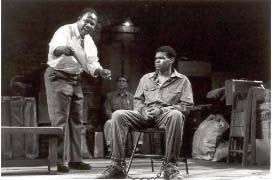
|
| Jamahl Marsh, as Jefferson, gets "A Lesson Before Dying" from Isiah Whitlock Jr., as his Former teacher. Photo: ©Susan Johann. |
"Cobb" [****]
I have no interest in baseball at all. Not in teams, stars, nor batting-averages. As a kid, I always managed to "chop wood" when the ball was pitched to me. Hopeless. I could never get to first. But playwright Lee Blessing has hit a home-run with "Cobb," creating a dramatic confrontation which should fascinate even those who have no interest in sports of any kind. It's more about humanity—or the lack of it, which often distinguished the spiteful and prideful Ty Cobb in his relations with others—than about baseball. Blessing peoples the stage with Three Cobbs, one brash and young, one in acerbic middle-age, and one in embittered seniority. There's also the disturbing ghost of the "Black Ty Cobb," to remind Cobb of his own racism—and the audience of the formerly all-white sport's color-bar. Producer Kevin Spacey was quite right to move this taut show from the Melting Pot Theatre's Off-off Broadway venue to the Lucile Lortel Theatre.
"Kit Marlowe" [****]

|
| Christian Camargo as playwright/spy Kit Marlowe, threatened by Jon DeVries as Queen Elizabeth's spy-master, Sir Francis Walsingham. Photo: ©Michael Daniel. |
"Book of the Dead: Second Avenue" [**]
Not having read the press-materials beforehand, I did not realize that I was watching a new kind of opera at the Public Theatre. Nor that its creator, John Moran, was believed by some to be a cutting-edge artist of great promise. Inspired by the imbecilic aleatory self-indulgences of the late John Cage, Moran has collaged a variety of overheard banalities of daily conversation. Stay away from Second Avenue, in future, unless you want to have the audio-visual effect of this slickly-produced show without paying for a ticket at the Public. For Moran, apparently words are music, so he has patched together—his actors only lip-synch—countless fragments of sounds and words to create this strangely numbing performance-event. It takes its title from the NYC street of the same name and from both the Egyptian and Tibetan Books of the Dead. Having recently been to Tibet and the Holy of Holies, Lhasa's Potala Lamasery, I find live Tibetans much more interesting than dead ones. And I find I like live shows more than dead—or deadly—ones. Halfway through the staged banalities—there were initially some Anubis-masked moments, true—a smoke-alarm went off clamorously. I thought it was part of the event, as we all pushed and shoved down the many stairs into Lafayette Street. But fire-trucks were just arriving in front of the theatre. I felt, somehow, that Mayor Guiliani would not have permitted the Public to call out the Fire Department for every performance of this show. But I could not face climbing back up all those stairs again. I was afraid that the Cliché Alarm would go off during the second half!
"Crossing Jamaica Avenue: Awakening" [***]
Playwright Chiori Miyagawa is not echoing John Moran in citing a city street in her title. Instead, she is giving long-gone feminist author Kate Chopin—and her once-controversial novel, "Awakening"—an opportunity to speak again through a new form of theatre. She, director Sonoko Kawahara, and some members of the cast belong to a new performance collective which is exploring uses of movement, voice, dramatic structure, and design beyond the conventional. In this new drama—simply but effectively staged at PS 122—she presents Kate Chopin—devastated at the critical rejection of her novel—as a sort of ritual Mistress of Ceremonies, commenting on her career, her novel, and its characters, passions, and plot. The fracturing of the latter, however, made me wish I'd read the novel beforehand. As interpreted, the central figures were not very compelling, either in passions or obsessions. Chopin's conception may have something to do with this, but, if the novel was so detested and despised in its time—before women were really free to follow their hearts and instincts, rather than obey strict social traditions of male-female roles and duties—her heroine must be a very powerful personality on the page. I do not know, not having read the original. Chiori was a grad student of mine at Brooklyn College, so I admire and follow her development as an innovative playwright. But we still write notes in the margins of the student papers…
"Alice in Bed" [*]
Even without the appalling visual clutter designed by Jan Versweyveld for "Alice in Bed" at New York Theatre Workshop, it would be difficult to sort out just what is supposed to be happening—if anything—in Ivo van Hove's deliberately fractured, obscured, and alienated production. Literary eminence Susan Sontag—if reports are to be believed—believes that this play is of major importance among her collected works. Perhaps she also believes she has created a new form of theatre, by envisioning William & Henry James' neurasthenic, bed-ridden sister, Alice James, having a tea-party with some famous literary ladies—Emily Dickinson & Margaret Fuller—as well as some mythical ones—Kundry & Myrtha. She's got the wrong Alice, and she's no Lewis Carroll. She's also a much better essayist than she is a dramatist. Dutchman Van Hove's avant-garde Deconstructivist trendiness plays well in Europe, but primarily for critics and sophisticates who are already terminally bored with theatre. Deconstructing a drama by Eugene O'Neill was bad enough, without picking on an inept but pretentious little sketch, pretending to be a play.
"Straight as a Line" [***]
Young Paulie is a hustler, suffering with AIDS. His Mum is a former hooker, now working in a Vegas casino. Their sado-comic confrontations—recently seen at Primary Stages—consist of 17 scenes, variously titled: Telecommunications, Motherhood, Transition, Baptism, Fragility, Redemption, Reckoning, Fencing, Reversal, Dementia, Love for Sale. Luis Alfaro's painful play was performed without intermission, featuring James Sie and Natsuko Ohama.
"The Beginning of August" [**]
The best thing about this new play by Tom Donaghy—at the Atlantic Theatre—was Mary Steenburgen. She played a recently widowed woman who desperately wanted to be included in her step-son's life and family.
"Big Potato" [*]
This Holocaust farce sadly proved pretty small potatoes for such an able playwright as Arthur Laurents. Its heroine—a survivor of various Nazi Death Camps—is convinced she's found a major SS Officer-killer in Kew Gardens, Queens. She lures him to her home beauty-parlor for a hair-dye job. Then she takes him prisoner. This was the initial offering in the Jewish Rep's new home on "New 42," the Duke Theatre, newly raised over the ruins of the collapsed Selwyn Building.
Other Theatre Manifestations—
"Requiem for Srebrenica" [hors de compétition]
If you need a striking example of Anti-Theatre, Olivier Py's lugubrious meditation on the savage massacre of Bosnian civilians by Serb troops—led by General Ratko Mladic—is a textbook classic. It is also Very French, having been created by the Centre Dramatique National/Orléans-Loiret-Centre. Three plain women, clad in androgynous black, dully recount testimonies of the horrors from published accounts and other sources. French critics of course raved about the power of this Post-Post-Modernist production, completely free of documentary photos or atrocity footage, deliberately devoid of potent emotive music, or of passion, gesture, or emphasis. As imported to—and performed recently at—BAM, the effect was narcotic, in the sense of sleep-inducing. Or of deadening the listener to the awful sufferings of the victims, living and dead. After all, none of this carnage might have happened if the late French President, François Mitterand—and his German counterpart, Chancellor Helmut Kohl—had not deliberately avoided engagement in countering the Ethnic Cleansings in the former Yugoslavia, referring to them instead as "internal affairs" and "domestic matters.""Guys & Dolls" at Museum of the City of New York [****]
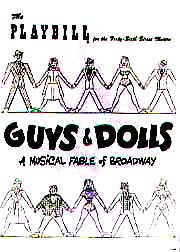
| |
| "Guys & Dolls" PLAYBILL cover from 1950 premiere. | |

| |
| Alvin Colt's original costume-design for Miss Adelaide's "Bushel & a Peck" number in Broadway's 1950 "Guys & Dolls." | |
Broadway columnist Damon Runyon—who celebrated the denizens of Broadway in the Prohibition Era and told their stories in magazine articles—is well represented. Including actual copies of the tales in the weeklies, as well as artifacts of their transformation for stage and screen: Shirley Temple, in "Little Miss Marker."
Ben Shahn's Public Works of Art Project paintings of New York during Prohibition and the Great Depression are also on view, along with other evocations of that lively time in Manhattan and the boroughs.
Rheba Crawford, a charismatic Times Square Salvation Army Lassie, is given her due as the model for the musical's heroine, Sarah Brown.
This attractively mounted exhibition will be on view until June 10 at the Museum of the City of New York. But it's only one element of a fascinating permanent third-floor celebration of New York Theatre over 150 years. "South Pacific" and the Astor Place Theatre Riot also star!
"Acting with Adler" [****]
This is not a new show, but a new book, by Dr. Joanna Rotté, who studied with the famed, talented, and beautiful actress Stella Adler. Member of an acting family with deep roots in the Yiddish Theatre, Adler was an acolyte of the great Russian actor-director-teacher, Konstantin Stanislavski. Though not quite as celebrated—or self-promoting—as Lee Strasberg, who claimed "The Method" as his refinement of Moscow Art Theatre acting principles, Adler surely understood the Master, his theories, and his practice better than Strasberg. What's more, she went to study with Stanislavsky and was one of the few great acting teachers who understood how his ideas had evolved over time—beyond what's laid down in "An Actor Prepares" and "Building a Character."This easy-to-understand handbook of Adler's teachings is just out in paperback from Limelight Editions, priced at $14.95 It is also an enjoyable read for anyone interested in the theatre and the art & craft of acting.
The careful reader may notice a citation of your reporter in the acknowledgments. In the interest of full personal disclosure, I should note that Professor Rotté—who teaches grad theatre at Villanova and acting at the Stella Adler Conservatory—wrote her CUNY Grad Center Theatre PhD dissertation with some guidance from me. She arrived in my office with pages and pages of notes she had taken over the years of eagerly attending Stella Adler's classes. But transcriptions—no matter how accurate—do not a dissertation make.
Stella was both charismatic and wonderfully inspirational. But she was not very well organized. Nor were the notes. What made Joanna Rotté's dissertation so outstanding was her organizing of Adler's ideas about both theory and practice into a clear-cut system. I believe Adler was more than astonished when she read what her devoted student had accomplished. She forbade its publication—but, after all, it was her system, her words. Fortunately, her daughter, Ellen Adler, has blessed Rotté's adept reworking of her dissertation into this much simpler, user-friendly text.
[Loney]
Copyright © Glenn Loney 2000. No re-publication or broadcast use without proper credit of authorship. Suggested credit line: "Glenn Loney, New York Theatre Wire." Reproduction rights please contact: jslaff@nytheatre-wire.com.
| home |
reviews |
cue-to-cue |
welcome |
| museums |
recordings |
coupons |
publications |
classified |